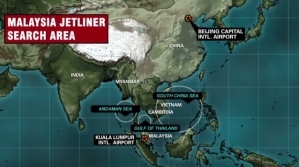
Highly anticipated communication data between the missing Malaysia Airlines Flight MH370 and Inmarst satellite systems were released earlier today, nearly two months after family members requested it be made public.
However, many are criticizing the content of the 47 page document, saying that the information lacks important elements that would help experts put the official version of the events to test, CNN reports.
The introduction to the document, which contains hundreds of lines of communication logs between the plane and the satellite system, states that it is simply "intended to provide a readable summary of the data communication logs."
Following the plane's strange disappearance, a team of international experts used the satellite data and other information, including radar data and engine performance calculations, to conclude that the aircraft ended up in a remote area of the southern Indian Ocean, according to CNN.
However, several skeptical family members of the missing passengers requested an independent analysis of the complex information, a painstaking process involving information that has yet to be released.
Michael Exner, one of the most vocal experts among those calling for the release of the data, explained that even an untrained eye could see severe gaps in the notes explaining the data.
The explanatory notes at the start of the document "answer a few of the questions we have had, but leave many questions unanswered," he told CNN.
CNN Safety Analyst David Soucie said certain key elements were noticeably missing.
"There's not enough information to say whether they made an error," he said. "I think we're still going to be looking for more."
Rupert Pearce, CEO of Inmarst Satellite Company, stated that the company would not release the full model to which it applied the data to estimate the plane's path until the Malaysian government gives the go-ahead.
"We'd be perfectly happy to put that model out," Pearce told CNN's "New Day."
But Pearce also told CNN that the released data is enough -- along with engine and radar data -- for experienced third parties to plug into their own models and reach their own conclusions.
Sarah Bajc, whose partner, Philip Wood, was on the missing jet, said she was "annoyed" that Inmarsat and Malaysian authorities hadn't released everything they used to reach their conclusions.
"I see no reason for them to have massaged this before giving it to us," she said.
Last week, the two sides stated they would attempt to make the information available to the public.
However, Bajc said the families had first asked for the data more than two months ago.
"It seemed a relatively innocent request" at the time, she said, but authorities refused to release it.
Malaysian officials told CNN earlier this month that their government did not have the data. But Inmarsat officials said the company provided all of it to Malaysian officials "at an early stage in the search."
"We've shared the information that we had, and it's for the investigation to decide what and when it puts out," Inmarsat Senior Vice President Chris McLaughlin said earlier this month.
A senior Malaysian official told CNN that the government needed Inmarsat's help to pass on the data to families "in a presentable way."
"We are trying to be as transparent as possible," the official said. "We have no issues releasing the data."
Bajc says Malaysia's failure to release relevant information is highly suspicious.
"It's a little curious to me why this had to become such a big deal," she said Tuesday.
Despite months of endless searching by dozens of planes in the southern Indian Ocean, no wreckage has turned up from the MH370.
The underwater search for the missing plane will be put on hold this week, and may not resume until August at the earliest, according to Australia's top transport safety official.
Analysts are optimistic that the release of the satellite data could help discount some theories about what happened to the jetliner, and potentially fuel new ones.







